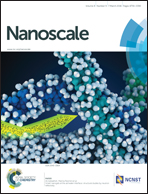Ultrasound-mediated modulation of the emission of gold nanodots†
Abstract
In this study, we employed ultrasound-based treatment to mediate the emission properties of (11-mercaptoundecyl)-N,N,N-trimethylammonium bromide-capped gold nanodots (11-MUTAB-Au NDs). The as-prepared 11-MUTAB-Au NDs (sizes: ca. 1.8 nm), obtained from the reaction of gold nanoparticles (ca. 3 nm) and 11-MUTAB, exhibited very weak red photoluminescence (PL) near 670 nm [quantum yield (QY): 0.01%] upon excitation at 365 nm. After ultrasonication (20 W) for 2 h, however, the 11-MUTAB-Au NDs exhibited a >1000-fold enhancement in their PL intensity (QY: 11.5%), which shifted to a green color (ca. 540 nm) with a longer PL lifetime, due to the smaller size of the resulting NDs and the higher density of their capping 11-MUTAB ligands. Moreover, the PL of the 11-MUTAB-Au NDs returned to the near-infrared region (ca. 810 nm) after ultrasonication for a long period of time (>5 h). The dramatically different optical properties of these alkanethiol-protected Au NDs after ultrasonication were presumably due to variation in their ligand densities; these effects were highly regulated by varying the ultrasonication time and power. Because the size, oxidation state, surface ligand density, and PL of these Au NDs could be controlled simply through ultrasonic treatment, this approach might open up new avenues for the preparation of emission-tunable metallic (e.g., Au, Ag, Pt) NDs presenting various capping ligands.


 Please wait while we load your content...
Please wait while we load your content...